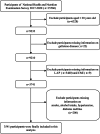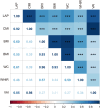Sex-specific adverse effects of lipid accumulation products and cardiometabolic indices on the prevalence of gallstones: insights from the 2017-2020 national health and nutrition examination survey
- PMID: 40696316
- PMCID: PMC12281679
- DOI: 10.1186/s12876-025-04099-0
Sex-specific adverse effects of lipid accumulation products and cardiometabolic indices on the prevalence of gallstones: insights from the 2017-2020 national health and nutrition examination survey
Abstract
Background: Anthropometric measurements and lipid profiles are associated with the onset of gallstone disease, with these associations exhibiting sex-specific variations. This study investigated the association between the prevalence of gallstones and two anthropometric-lipid markers, namely Lipid Accumulation Products (LAP) and Cardiometabolic Index (CMI), while also assessing the presence of sex disparities.
Methods: Data from the 2017-2020 National Health and Nutrition Examination Survey (NHANES) were analyzed, including 3,541 participants aged 20 years or older with complete information. Weighted logistic regression, restricted cubic spline modeling, and subgroup analyses were employed to assess the relationship between LAP and CMI and gallstone disease, as well as to investigate potential sex-specific differences. An analysis of the receiver operating characteristic (ROC) curve was performed to assess the prediction accuracy of indices and to determine appropriate cutoff values.
Results: Elevated LAP and CMI were significantly correlated with an increased prevalence of gallstone disease among women, whereas no significant association was found in men. For each unit increase in log2-LAP, the multivariable-adjusted odds ratio (OR) for gallstone disease was 1.375 (95% CI: 1.143-1.655). For each 1-point increase in CMI, the multivariable-adjusted OR was 1.408 (95% CI: 1.098-1.806). Quartile analysis demonstrated that higher levels of LAP and CMI were significantly associated with an increased prevalence of gallstones. The associations between CMI, LAP, and the prevalence of gallstones were consistent across all subgroups (p for interaction > 0.05). LAP exhibiting the largest AUC, demonstrating high accuracy in screening for high-risk individuals for gallstone disease, comparable to traditional indices.
Conclusions: The study revealed a positive association between LAP, CMI, and the prevalence of gallstones, observed exclusively among women. The findings suggest that prioritizing the reduction of LAP and CMI is crucial for preventing gallstone disease in women.
Keywords: Cardiometabolic indices; Gallstones; Lipid accumulation products; NHANES.
© 2025. The Author(s).
Conflict of interest statement
Declarations. Ethics approval and consent to participate: This study used anonymous data from the National Health and Nutrition Examination Survey and complied with the ethical guidelines and regulations of the Declaration of Helsinki. The study was approved by the National Center for Health Statistics Ethics Review Board, and all participants provided written informed consent before the study. Consent for publication: Not applicable. Competing interests: The authors declare no competing interests.
Figures




References
-
- Wang X, Yu W, Jiang G, Li H, Li S, Xie L, Bai X, Cui P, Chen Q, Lou Y, et al. Global Epidemiology of Gallstones in the 21st Century: a systematic review and meta-analysis. Clin Gastroenterol Hepatol. 2024;22(8):1586–95. - PubMed
-
- Lammert F, Gurusamy K, Ko CW, Miquel JF, Méndez-Sánchez N, Portincasa P, van Erpecum KJ, van Laarhoven CJ, Wang DQ. Gallstones. Nat Rev Dis Primers. 2016;2:16024. - PubMed
-
- Stinton LM, Myers RP, Shaffer EA. Epidemiology of gallstones. Gastroenterol Clin North Am. 2010;39(2):157–69, vii. - PubMed
-
- Konyn P, Alshuwaykh O, Dennis BB, Cholankeril G, Ahmed A, Kim D. Gallstone disease and its association with nonalcoholic fatty liver disease, all-cause and cause-specific mortality. Clin Gastroenterol Hepatol. 2023;21(4):940-948.e942. - PubMed
-
- Shabanzadeh DM, Skaaby T, Sørensen LT, Jørgensen T. Screen-detected gallstone disease and cardiovascular disease. Eur J Epidemiol. 2017;32(6):501–10. - PubMed
MeSH terms
LinkOut - more resources
Full Text Sources
Research Materials

